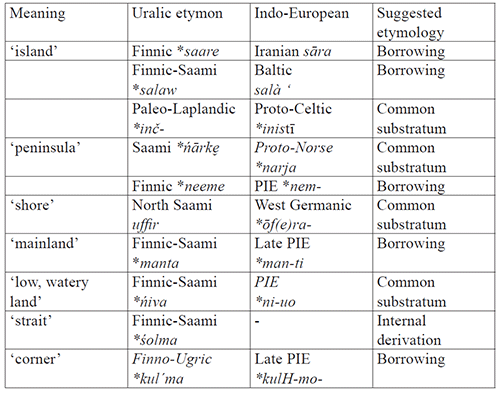One of the most interesting aspects for future linguistic research, boosted by the current knowledge in population genomics, is the influence of Uralic – most likely spread initially with Corded Ware peoples across northern Europe – on early Indo-European dialects.
Whereas studies on the potential Afroasiatic (or Semitic), Vasconic, Etruscan, or non-Indo-European in general abound for ancient and southern IE branches (see e.g. more on the NWIE substrate words), almost exclusively Uralicists have dealt with the long-term mutual influences between Indo-European and Uralic dialects, and often mostly from the Uralic side.
Sections:
- Italo-Celtic – West Uralic:
- Borrowings from Uralic (substrate language of geminates?) into Celtic.
- Borrowings from (Italo-)Celtic into Finn(o-Saami-Mordvin)ic.
- Chronology of the contacts.
- Germanic / Balto-Slavic – Uralic.
- Uralic hotspot in Eastern Europe:
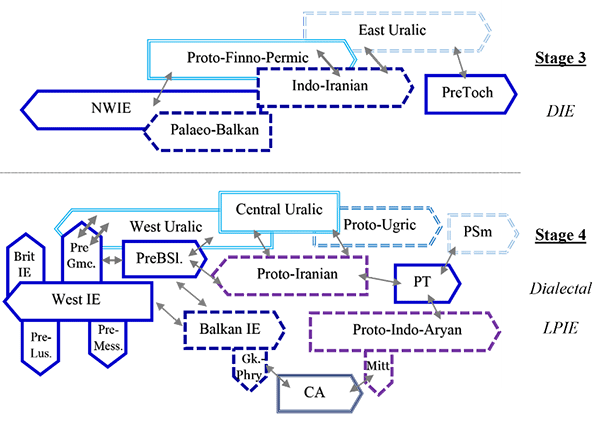
I. Italo-Celtic – West Uralic
I was waiting for more data on Single Grave and heavily admixed Bell Beakers from the Low Countries and surrounding Lower Rhine territories to write about the potential Uralic (instead of simply “Afroasiatic-like”) substratum of Insular Celtic, which I already advanced, but here is nevertheless a recent related draft – Contacts between Finnic and Celtic? by Merlijn de Smit (2019), evaluating potential Italo-Celtic – (West) Uralic interactions.
Relevant excerpts (emphasis mine), omitting references to previous Uralic loanwords in Celtic proposed by Schrijver (1997, 2001) or Hyllested (2010, 2016):
I.1. Borrowings from Uralic (substrate language of geminates?) into Celtic
Proto-Celtic *kani ‘good, nice’, Old Irish cain, Middle Welsh cein. (…) It is matched in Finnic by the verb kania ‘put in order, improve, clean’ and the adjective kanea ‘good, pretty’ with cognates in Karelian, possibly Estonian, but not outside Finnic. The verb could be a denominal causative similar to tahria ‘smudge’ from tahra ‘stain’ (Hakulinen 1979: 283), the adjective shows a denominal *-eδa. This means that an underlying *kani or *kana with the meaning ‘good’ or ‘nice’ can be reconstructed in Finnic. (…)
Proto-Celtic *druko- ‘bad’, Old Irish droch, with cognates in Continental Celtic personal names. Matasović (EDPC) holds the Indo-European etymology (PIE *dhrewgh- ‘deceive’ or *dhrowgh-s / *dhrugh-os ‘deceit’) to be uncertain and lists it as a possible non-IE substratum item. The matching term in Finnic is turka, turkka ‘poor, miserable’ and the expletive turkanen ‘wretch’, with cognates in Votic and Estonian and possibly in Saami as well (SSA).
This seems like a really weak case to me, involving potential Indo-European origins of the Finnic word, as well as needing strictly Finnic sound laws. De Smit reinforces this with the potential adoption of a semantic pair with ‘good’.
Proto-Celtic *wē(t)tā ‘stream, swamp’, Old Irish féith ‘marsh, swamp’ is listed by Matasović (EDPC) as a possible substratum item, though he does consider derivation from PIE *weyh1 ‘wither’ (IEW: 1123). Matasović does not list any Continental Celtic cognates. The term is similar to Proto-Uralic *weti ‘water’ (Sammallahti 1988: 541, UEW: 570-571). Finnic reflexes such as Finnish vesi are also used to designate bodies of water such as lakes. The long vowel in Celtic is curious, however, as is the variation between a single and a geminate stop. If the Proto-Celtic form could be a blend of underlying *wettā and *wētā, perhaps an indirect borrowing through the ‘language of the geminates’ (Schrijver 2001: 420) could be a possibility. (…)
A potentially weak case, given the existence of Gmc. *wēta- ‘wet’ from PIE *wed-, and the known intense Celto-Germanic contacts, although phonetically such a direct loan is not straightforward, either.
Proto-Celtic *nino- ‘ash-tree’, Middle Irish nin, possibly attested in Gaulish toponymy as well, is considered a likely non-IE borrowing by Matasović (EDPC). The equivalent on the Uralic side would be Finnic-Permic *nini, *ńini (UEW: 707), Finnish niini ‘inner bark of the linden’, ‘linden’ (SSA, SKES). In related languages, reflexes of *nine as such refer to the bast or inner bark of the linden tree, but compositions such as ńiń-pu in Udmurt, niinipuu in Finnish (puu ‘tree’) refer to the linden tree. These compositions could well have existed in Proto-Finnic, and the designation *nini could have been taken to refer to the tree during a process of borrowing, if this secondary meaning did not already exist in the donor language (as it does in Finnish). The main problem with this comparison is the semantics. Designations of trees can shift, of course (…) In Fennoscandia, the linden has a more northernly limit than the ash-tree, which is somewhat rare in Finland; though in Western Europe, the situation is inverse, with the ash-tree more widespread in the Low Countries and the British Isles. (…)
Proto-Celtic *gargo- ‘rough’ and *garwo- ‘rough, coarse’ are not regarded as substrate items by Matasović (EDPC) but rather as expressive: Matasović is sceptical to suggested Indo-European parallels. The word-pair is reminiscent of a similar one in Uralic: *karwa ‘bitter, sharp, stinging’ (UEW: 128-129) and Finno-Permic *karki ‘rough’ (UEW: 646-647). The matter is complicated, however, by the fact that both reconstructions in UEW compete with Germanic loanword etymologies for the Finnic reflexes (Finnish karkea ‘rough, bitter’ and karvas ‘bitter’). (…) West Germanic *harwa could also belong here if the Indo-European etymology (from *kor-uo- ultimately from *ker- ‘to cut’ (Kroonen, EDPG; IEW: 938-947)) is rejected: the limited spread of the Germanic item could justify assuming an Uralic borrowing instead. A problem with this suggestion is Proto-Celtic initial *g- instead of *k-.
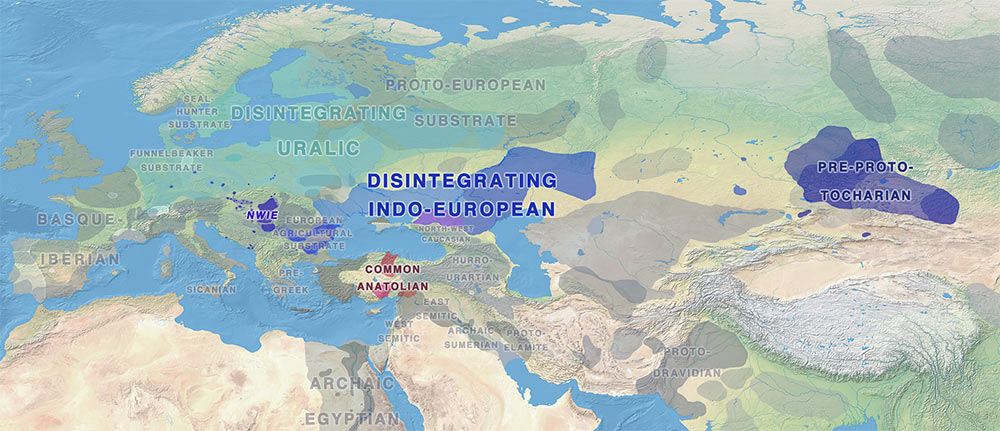
I.2. Borrowings from (Italo-)Celtic into Finn(o-Saami-Mordvin)ic
Finnish mieto ‘mild, weak’, which is extant only in Finnish and of unknown etymological origin (SSA, NES, not in SKES). A possible Celtic donor form would be *mēto, *mēti ‘fat, soft’ (EDPC) which rests on a dental extension of PIE *meyH- ‘mild, soft’ (IEW: 711-712). These dental extensions are only found in the Celtic reflexes of the Indo-European term as well as in Latin mītis ‘mild, soft’ (EDL). We would thus be dealing with an Italo-Celtic isogloss here (…)
Finnish nero ‘sense, understanding, power, genius’, nerokas ‘brilliant’ has cognates in Karelian and Ludic, and no further proposed origins (SSA, NES, SKES). I would suggest a borrowing from Proto-Celtic *nero- ‘hero’, a reflex of PIE h₂ner- ‘vital energy, man’ (EDPC; IEW: 762), represented in Greek ἀνήρ ‘man’. In terms of semantics, a meaning ‘vital energy’ would account very well for the meanings of the Finnish term – but in Celtic, that meaning is associated with a derived term, e.g. Breton nerz ‘power’. Germanic cognates are names of divinities such as Nerthus, likewise derived. To account for the Finnish form, we would need a donor form without the dental suffix, such as Proto-Celtic *nero- or Old Indic nár ‘man’. Indo-Iranian loanwords in Finnic are well-established, but this would in this case have to be a Pre-Indo-Iranian loanword predating the shift from PIE *-e- to PII *-a-. Alternatively, we are left with Proto-Celtic *nero- ‘hero’ and Proto-Italic *ner-o- ‘strong’. If a meaning such as ‘forceful’ or ‘vital energy’ could be assumed for Proto-Celtic as well, the Celtic and Finnic terms would match both semantically and phonologically.
Finnish musta ‘black, dirty’ is spread throughout Finnic (SSA). It may be related to a set of Saami terms such as North Saami mosstas ‘thick, cloudy’ (Rauhala 2011: 276) or these Saami terms may have been borrowed from Finnic (SSA).
This seems like a weak proposal needing questionable recent sound substitutions.
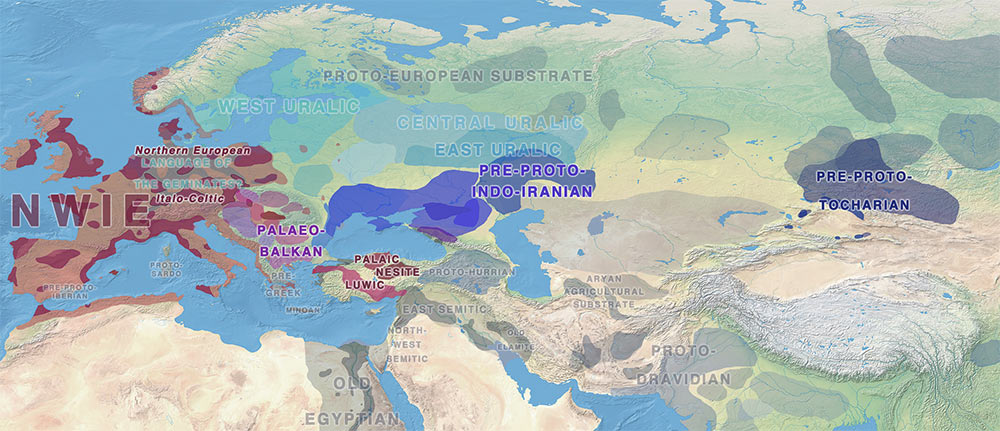
I.3. Chronology of the contacts
The term that shows the most chronologically specific phonological features on the Uralic/Finnic side is Proto-Celtic *magos < West Uralic *maxi (<PU *mi̮xi). The Uralic term would precede the loss of word-internal *-x- early in Proto-Finnic (Kallio 2007: 231-232) but postdate the shift from PU *i̮ -i to *a-i in Finnic-Saami-Mordvin (Sammallahti 1988: 546, Aikio 2015: 34). Kallio (2006: 16-17) dates a unitary Uralic proto-language to as late as 2000 BC, and Proto-Finnic-Saami to the last millenium before Christ (Kallio 2006: 14). A timeframe of 1000 BC – 1 BC would fit the borrowing of Proto-Celtic *magos, whereas Proto-Celtic *sowk-n-o ‘suck’ which has cognates in Germanic, Italic and Baltic and which Schrijver (2001: 423) ascribes to an indirect borrowing through the ‘language of the geminates’ may be earlier, due to its larger spread in Indo-European. Of the possible borrowings mentioned above, Proto-Celtic *lubī/ā ‘worth, plant’ and Proto-Celtic *klamo- ‘sick, suffering from leprosy’, suggested by Hyllested (2010) are compatible with a common Finnic-Saami or Finnic-Saami-Mordvin proto-language. The same goes for Proto-Celtic *nino- ‘ash-tree’, Proto-Celtic *wē(t)tā ‘stream, swamp’, and Proto-Celtic *gargo- ‘rough’.
Kallio’s latest chronology of of Proto-Uralic and Finno-Mordvinic evolution differs from the old (2006) paper referred to by De Smit, with a slight shift towards earlier dates.
Words that suggest a possible later, specifically Proto-Finnic donor language, would be Proto-Celtic *mokku- ‘pig’ and *tworko ‘boar’ suggested by Hyllested (2016). Both of these terms show internal derivations specific for particular Finnic daughter-languages: this makes these etymologies uncertain. Proto-Celtic *kani ‘good, nice and *druko ‘bad’ have comparanda that are extant only within Finnic, even though their internals would be in principle compatible with an earlier origin. If the similarities are not due simply to chance, however, a common substratum would be a possible explanation here. Proto-Celtic *sukko- ‘sow’, which is the strongest of Hyllested’s (2016) porcine etymologies, is a more complex matter. The velar vowel in Karelian čugu ‘pig’ is matched by Mordvin tuvo ‘pig’, but they must be of different origins. The initial affricate or sibilant presupposed by the borrowing etymology suggests an original Proto-Finnic *tika > *tsika which then secondarily received its velar vowel, and therefore the borrowing cannot predate Proto-Finnic. Of the items mentioned above, only Proto-Celtic *magos and *sowk-n-o would compel us to earlier donor forms, and even here, very early Proto-Finnic could have been a source language.
The three terms for which I suggested a Celtic borrowing etymology all seem somewhat archaic for Proto-Celtic. In terms of semantics, all three would presuppose meanings that are better preserved in sister clades of Proto-Celtic, such as Italic, or meanings reconstructible to Indo-European, than any Celtic daughter languages. Furthermore, Finnish musta ‘black’, if my suggestion above holds, would presuppose a Pre-Celtic form in terms of phonology.
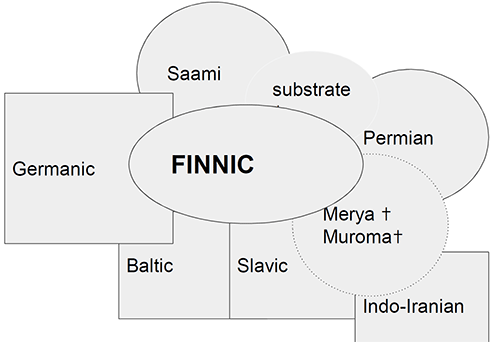
Merlijn De Smit continued his draft on Italo-Celtic – Uralic contacts trying to find a fitting archaeological setting for them, taking into account that the Battle Axe culture would have spread an (unknown third or substrate) Indo-European language in potential contact with a West Uralic-speaking Netted Ware, etc. It is becoming evident that the traditional archaeological Uralic-speaking Volga-Kama vs. NWIE-speaking Corded Ware homelands have become obsolete in linguistics as in population genomics.
Even researchers who seem to keep blindly accepting that Corded Ware – and thus today anything resembling the so-called “Steppe ancestry” – might have spread with Indo-Europeans have recently noted the lack of information on the dialect spread by this culture, given the discontinuity of Corded Ware-derived groups except in regions where Uralic-speaking peoples emerged. So, for example:
- The recent Mallory, Dybo and Balanovsky (2020) find that Corded Ware is too early to represent any of today’s dialects, probably based on Mallory’s (2013) previous idea that Bell Beakers represent North-West Indo-Europeans;
- Anthony (2019) supporting the now evident connection of Pre-Yamnaya ancestry and the expansion of R1b-L23 lineages with Proto-Indo-Europeans from the Middle Volga (Khvalynsk), and later of the Don-Volga region (Repin) expanding with the Yamnaya and Afanasievo;
- and even Kortlandt, who now also agrees with Khvalynsk as the Indo-Anatolian community, and identifies his “Indo-Slavonic” – supposedly the last to have split off from the parent Graeco-Aryan dialect (in turn more innovative than Northern Indo-European, including West Indo-European and Tocharian) – with the Srubnaya-Andronovo horizon.
NOTE. How exactly those supporting an “Indo-Slavonic” dialect would frame an expansion of Srubnaya into the Baltic and later as a surviving Slavic branch of Eastern Europe is unknown, but this seems still more reasonable than identifying “Indo-Slavonic” with Corded Ware. And describing an Indo-Slavic Srubnaya as “reasonable” is already saying something about the mess that some academics like those connected to the Copenhagen lab are helping create…
II. Germanic / Balto-Slavic – Uralic
Apart from the obvious Uralic substrate underlying Germanic phonetic evolution, as well as Balto-Slavic phonetic and morphosyntactic developments, there is a clear, strong, and (at least in appearance) mainly one-sided lexical influence of the Northern Indo-European community around the Baltic on West Uralic.
Many of the adopted terms include maritime (coastal or “seafaring”) terms, as explained in Insular Etymologies: Indo-European and substrate coastal terminology in Finnic and Saami, Finnisch-Ugrische Mitteilungen (2018) 41.
This might suggest that Indo-Europeans were the first to settle the Baltic, ergo Corded Ware peoples spoke Indo-European. That is how this question has been traditionally (and very simplistically) framed, as it was some years ago in the thesis by Mikko Heikkilä about potential ancient Indo-European hydronyms on the Finnish coasts, or more recently in the attempts by Kallio. Until recently, most of us considered Corded Ware to be the most likely vector of North-West Indo-European, so it was only natural to accept this “third lost language” explanation for Eastern Europe.
However, while some terms seem to come from a non-IE, non-Uralic substrate language, and others are of late (Palaeo-Germanic, late Balto-Slavic) adoption, some of these terms are difficult to reconcile with a specific Indo-European dialect. In fact, they can be easily attributed to the Old European expansion; more specifically, to the Northern Indo-European dialect continuum spread with Bell Beakers along the Baltic shores.
The most striking finding by linguistics before archaeology is therefore that it alone could have explained that Bell Beakers represented the true maritime elite that united southern Scandinavia (and eventually a great part of the South-East Baltic), based on the early borrowings stemming from a time when Germanic and Balto-Slavic were not clearly differentiated, and on late ones during their dialectal expansions. The clear division of Battle Axe vs. Single Grave groups (and their distinct Y-DNA bottlenecks) further attests to the lack of maritime prowess or intense contacts between both groups, both spreading mainly through different (northern and southern) land routes and remaining mostly isolated from each other for centuries.
Furthermore, the linguistic influence was actually bilateral around the Baltic (including Scandinavia), with old Finn(o-Ugr)ic borrowings in Balt(o-Slav)ic probably including – among many other less likely cases and strong phonomorphosyntactic substratum – words for ‘juniper’ (cf. OPr. kadegis, Latv. kadiķis, Lith. kadagỹs, PFi. kataka, Fi kataja), ‘island’ (Lith. salà, Latv. sala, Liv. sala, Est. salu, Fi. salo)*, ‘polecat’ (cf. Lith. šẽškas, Fi. dial. häähkä, MariE šaške, MariW šäškə), ‘strap, belt, leather’ (cf. Lith. šikšnà, PFi. *hihna), and ‘glove’ (Bal. *kimdas, Fi. kinnas, gen. kintaan, Est. kinnas, kinda, Veps, kinds, kindaz, Liv. kindas, k’indaz, in which the sequence -mT- instead of Late Proto-Finnic -nt- indicates an early reconstruction level on the Uralic side).
*While sal- has a fairly established NWIE etymology for a water body, possibly including Lat. insula < *in-sal-, the direction of borrowing (if any) is unclear in the case of the Baltic term.
NOTE. For a comprehensive and critic view of Finno-Ugric loans in Baltic languages, see Junttila (2012, 2015), Laakso (2019).
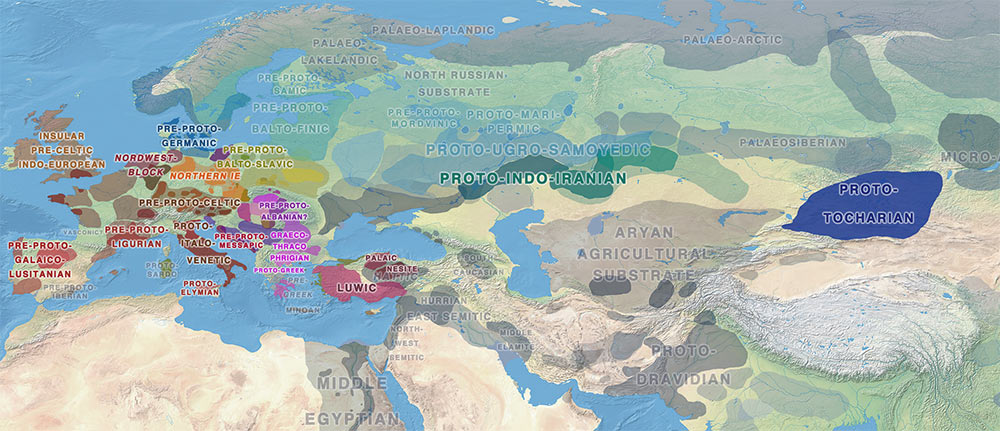
III. Uralic hotspot in Eastern Europe
Data confirming the Uralic-speaking nature of the Corded Ware culture comes thus from the Uralic substratum underlying most languages of North-Central Europe, and most especially the Baltic Sea and Eastern Europe, where its intense influence on Balto-Slavic (particularly Slavic, but also dialects around the Baltic circle) and especially Indo-Iranian is undeniable.
I will comment here only three cases where a Uralic origin of a borrowing seems at least equally possible as an Indo-Iranian one, two of them presented by Chetan in one of my latest posts, concerning ideas he wrote about in his blog a year ago. I will not discuss PII *ásura-, though, for which an Indo-European etymology and a late adoption by Uralic dialects in contact with the Volga-Urals can be easily assumed.
NOTE. There were certainly Uralic borrowings in Indo-Iranian, despite this being an under-researched aspect among Indo-Europeanists: you can read about some proposed Uralic borrowings in Indo-Iranian, including those briefly discussed in the recent Holopainen (2020).
III.1. Uralic *orja ~ Indo-Iranian **ā̆rya-
A Proto-Uralic origin for (West and Central) *orja would be as compatible as an Indo-Iranian origin on the formal aspect, and it has the advantage to be consistent with the archaeological and genomic evolution of Indo-Iranians. In fact, it is not the first time that a Uralic origin for the term has been proposed.
- Indo-European origin.
- Uralic origin.
- Indo-European through Uralic or vice versa.
- Chance resemblance?
III.1.a) Indo-European origin
Reasons for the connection between “Aryan” and an Indo-European etymology include the traditional reconstruction in Pokorny (IEW:24,67) of *aryo- ‘master, lord’ encompassing Ai. ar(i)yá-, ā́r(i)ya-, Av. airyō, OP ariya-, but also Gaul. Ario-mānus, OIr. aire, and ON arjostēR.
The traditional reconstruction of the Germanic forms related to Gmc. *harja- must today be rejected, since it is more straightforwardly derived from NWIE *kor-io- ‘tribe, clan; troop, army’.
Matasović (2009) reconstructs Cel. *aryo- ‘free man’ based on OIr. aire, Gaul. Ario-manus, Ario-vistus, hence potentially *h₂ery-o- ‘host’ (?) [sic] based on the traditional IEW, and on the potentially “original” RV arí- ‘guest, stranger’ (Mayrhofer).
On the other hand, such a word for ‘guest’ is unattested elsewhere, and Meid (2005) reconstructs the Celtic word as from PIE *pr̥h₃- ‘first’, hence from *pr̥h₃-yo- ‘foremost, leading’, although Matasović (2009) considers that this reconstruction would rather give a regular Cel. **frāyo.
However, compare (following Gąsiorowski [2017]) the common prefix Cel. *(φ)ari- ‘in front of, fore-‘ (OIr. air-, Gaul. are-, etc.). In fact, OIr. aire (*<arisak-) ‘freeman, nobleman’ is a k-stem, which doesn’t have a parallel in Indo-Iranian.
The lack of convincing semantic and phonetic cognates to the Proto-Indo-Iranian term leaves an Indo-European reconstruction as just one possibility, especially because it could be alternatively reconstructed as from Pre-PII *-r- or *-l-, and from Pre-PII *-a- or *-e-, or even (doubtful given the potential relationship to *arí-) *-o-.
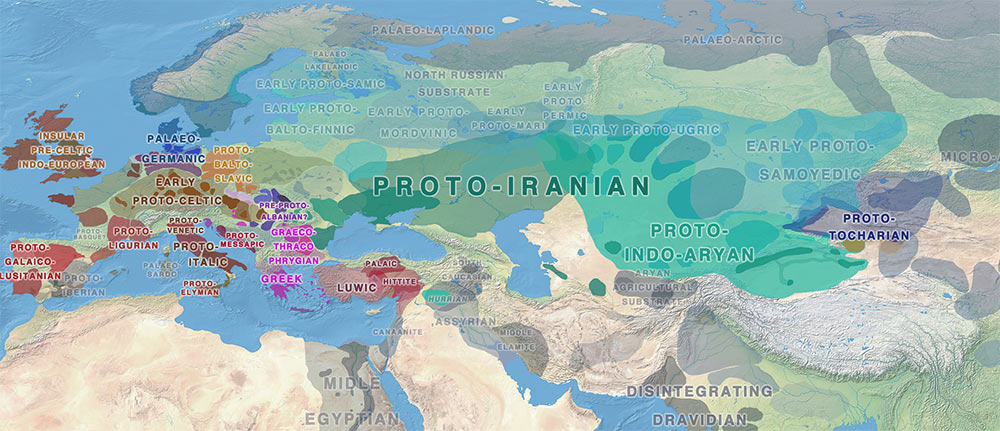
III.1.b) Uralic origin
Reasons why *ā̆rya- doesn’t seem to be an Indo-European word, but rather an Indo-Europeanized one:
1. The clearly related Finno-Saami-Mordvinic and Permic terms point to a Finno-Permic or (if such a traditional grouping is rejected) a slightly older (Disintegrating?) Proto-Uralic origin of the word that might have diffused through areal contact, suggesting a Pre-Indo-Iranian borrowing as the most likely stage, which contrasts with the proposed (late) Proto-Indo-Iranian borrowing from a lengthened *ā́rya-. It seems more likely, then, that a common Uralic term *orja would have been adopted as *ā̆r(i)ya- ‘lord, leader; host, master’ and then derived into *aryá- ‘kind, hospitable’, but also RV arí- ‘guest, stranger’.
NOTE. While this kind of (potential) back-formations might be seen as a weak semantic argument for a Uralic origin, the adoption of the loanword exactly during the Proto-Indo-Iranian ethnogenesis and expansion helps explain the phonetic variability of the reconstructed Indo-Aryan and Iranian forms, similar to the variability found in the European agricultural substrate.
2. It is strange that such a strong autonym as “Aryan” for Indo-Iranians would develop only in one branch, the one (if Corded Ware is assumed to have been an Indo-European-speaking community) that dominated over the Yamnaya-like steppe herders from Poltavka (hence also Indo-European-speaking), while all other groups from Europe, whether from Northern or Graeco-Aryan dialects, kept the common Indo-European self-denomination *teuta ‘people’, or the common ethnonym *wenét- ‘winner’ (see here), among other, less generalized ones.
The Indo-Iranian example looks rather like the case of Greek, where the main term for ‘people’ was also replaced, probably under the strong Pre-Greek substrate influence visible linguistically, culturally, and genetically (see e.g. here). Similarly, although much later, for Latins (based on Rome) or Slavs (based on what looks like a place name, too).
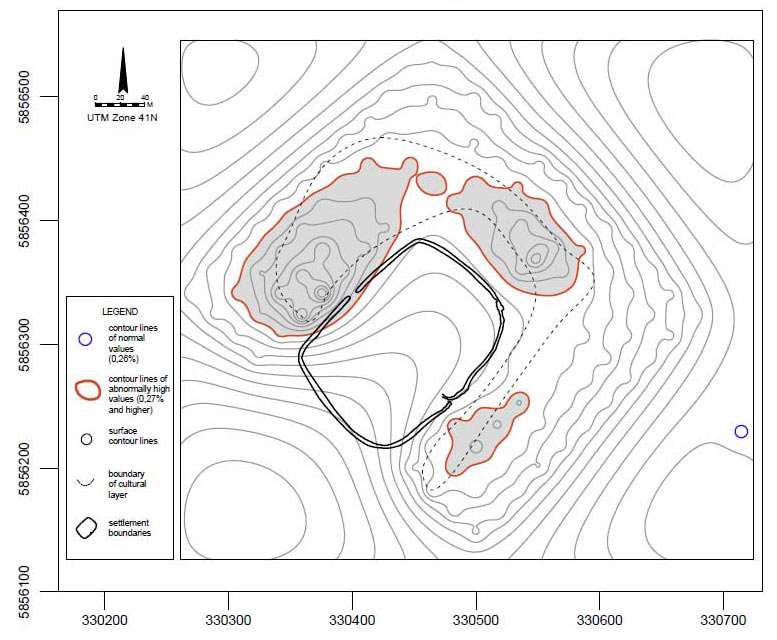
3. Originally *orja may have meant simply ‘south’, with a variable cardinal meaning also attested for PU *luwe ‘south?, east?’. As Pystynen [2017] noted, PSa *oarjē means ‘south, southwest, west’, rotating the cardinal direction depending on which direction rivers run in a specific area. This variability might also be related to the position of the Sun and the mythical location of the dark underworld and the sunny heaven (see below for the Slavic borrowing).
#EDIT (7 FEB 2020): As Chetan notes in the comments, there are some interesting data from languages that show common riverine (or other geographic) coordinates as cardinal ones, so one might propose that ancient Uralic peoples of the Forest Zone between the Dnieper, Don, Volga, and Ural rivers could have generally assumed that ‘south’ and ‘downstream’ were one and the same. Therefore, the meaning ‘southerner’ might have been used as an exonym by those upstream of the Don-Volga-Ural river basins to refer to those inhabiting the steppes to the south.
It does seem quite a stretch to assume that from an original intermediate ‘south(ern(er))’ meaning in Uralic it would have been used as an autonym among East Uralic peoples, and ‘slave’ would develop related directly from the relationship between West Uralic (Battle Axe) and Central Uralic (Fatyanovo-Balanovo) importing slaves from East Uralic (Abashevo) communities, especially because this term doesn’t appear in Ugric or Samoyedic branches.
However, contra Pystynen [2017], an exonym meaning ‘southerner’ may have been adopted as endonym in a multilingual community where the original meaning was eventually lost due to language shift. Thus, an original name used by East Uralic-speaking Abashevo to refer to Pre-Proto-Indo-Iranian-speaking Poltavka herders could have been eventually adopted by the whole Indo-Iranian-speaking community of Sintashta-Potapovka-Filatovka, which would strengthen the idea of a linguistic transition from Uralic to Indo-Iranian, as Abashevo chiefs adopted the Poltavka culture. For more on how such a process could have developed, there is a similar case among Australian tribes.
NOTE. For more on the complex social development of fortified settlements around the Southern Urals, read Igor Chechushkov’s thesis Bronze Age human communities in the Southern Urals steppe: Sintashta-Petrovka social and subsistence organization (2018), and recent papers on Sintashta-Petrovka and Potapovka cultures.
This interpretation would thus fit an ethnonym used by Abashevo chiefs to describe the Indo-Iranian peoples on their southern border that became simultaneously (i.e. during the Pre-Proto-Indo-Iranian stage) a synonym for slave in the north-west due to intense contacts between Abashevo, Fatyanovo-Balanovo and Battle Axe communities. This would perfectly fit the known timeline of borrowings in West Uralic that spanned the mid- to late 3rd millennium, and that are difficult to explain otherwise.
Slave exchange related to this term has been traditionally assumed by many Indo-Europeanists and Uralicists alike, and routes of slave commerce have its (reversed) parallel in a more recent period in Eastern Europe, during the East Slavic ethnogenesis:
NOTE. While slavery seems to be a taboo word for archaeologists, population genomics is confirming the linguistic reconstruction of this economic institution among prehistoric cultures.
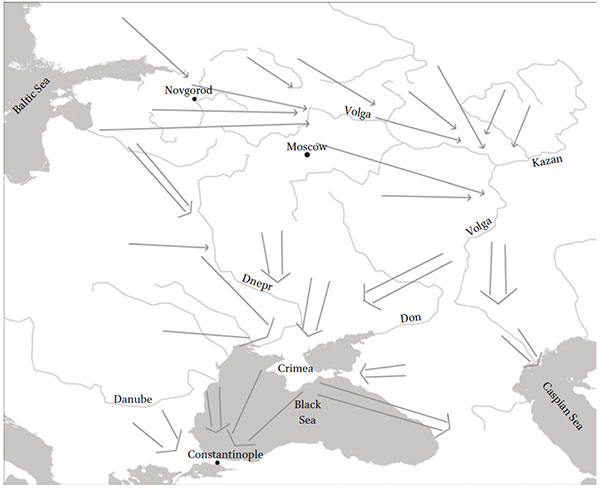
4. The common term Vyraj ‘paradise’ found in Slavic mythology, as a southern land where birds fly for the winter and souls go after death, is clearly reminiscent of the reconstructed Proto-Uralic mythology, and (at least the forms in *vyr-) have no clear parallels outside Slavic, but are fully compatible with an origin in a derivative from PU *orja (so e.g. in Holopainen 2020).
NOTE. Maybe related to other Slavic forms is Bal. *jūra ‘sea’, although according to Derksen (2015) the Baltic forms are probably related instead to PIE *u(ᵉ/ₒ)h₁-r-, a parent form which doesn’t fit a potential reconstruction of Sla. *jьrъ. In any case, it seems impossible to reconstruct a single Proto-Slavic term, which is a well-known consequence of taboos distorting the phonetic evolution of religious terms.
The adoption of this term and meaning suggests that derivatives of *orja were widespread among Uralic-speaking groups that survived well into the Iron Age in the Dnieper and Daugava basin, who were eventually absorbed by the Proto-(Balto-)Slavic community in Eastern Europe; this scenario of acculturation of Uralic speakers is historically supported for East Slavs, including recent finds of population genomics (see here or here).
The shift to a mythological meaning of *orja in the Uralic-speaking community that became the substrate of Proto-Slavs – probably replacing the original PU *suŋe ‘summer; the southern abode’ – has a parallel in the Indo-European pairs of words of mythological vs. real ‘fire’ & ‘water’, which were eventually reduced to one term in most dialects. This semantic development also supports ‘south’ as the original meaning of *orja in Disintegrating Uralic, rather than the more specific of ‘slave’ found in Balto-Finnic or Permic.
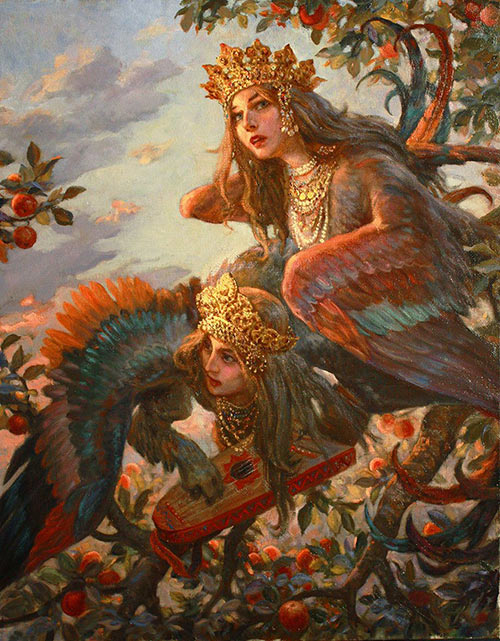
5. As can be inferred from my reasoning above, rather than a hypothetical Ugro-Samoyedic autonym proper which might have disappeared in all attested dialects, I prefer the hypothesis of a reinterpretation of a common Uralic adjective *orja meaning ‘south’ (maybe also ‘downstream’) that would have been used by East Uralians from Abashevo to refer to the ‘southerner’ Pre-Proto-Indo-Iranian-speaking Poltavka peoples of the Volga-Ural region, and (more or less simultaneously) shifting its meaning in those territories of Finno-Permic speakers of Battle Axe and Fatyanovo-Balanovo dealing with slaves.
The term would have been eventually used by Proto-Indo-Iranians themselves as autonym evolving into the known alternative *ā̆rya- forms, coinciding with the language shift and known phonetic changes from Pre- to Proto-Indo-Iranian by the (originally Uralic-speaking) patrilineal elites from Abashevo that formed the ruling minority of the Sintashta-Potapovka-Filatovka community, potentially involving a sort of radical cultural rejection of the forest communities, coupled with the adoption of the culture of their (real or assumed) Poltavka steppe ancestors, as Anthony (2007) suggested.
I particularly like this theory because it might be directly supported by population genomics: if samples of Yamnaya ancestry, especially males of hg. R1b-L23 (and more specifically of R1b-Z2103 lineages), appear in the areas settled by expanding Abashevo peoples – or even in Central Uralic-speaking Fatyanovo-Balanovo and up to West Uralic-speaking Battle Axe culture – under ‘poor’ burial conditions relative to elites of Corded Ware-like ancestry, akin to those found e.g. in the recent Mittnik et al. (2019) paper – we will be able to assume that the hypothesis is valid.
#EDIT (7 FEB 2020): Unlike in recent times under organized societies, such as the often-cited Early Medieval commerce of Slavs in Western Europe, it appears less likely that there would have been a large-scale commerce of Indo-Iranian slaves spanning from the Urals to Scandinavia, so it would be more reasonable to assume that prehistoric cultures relied on war and raids on neighbouring regions to obtain a supply of servants, and that strong cultural ties were enough to borrow the word – as can be assumed for the indirect contacts between PWU Battle Axe and Pre-PII Poltavka.
III.1.c) Indo-European through Uralic or vice versa
Impossible to prove or disprove are also more speculative intermediate steps, such as:
- Koivulehto’s (1999) derivation from a hypothetic Satem loan from PIE *worgʰo- ‘work’: although semantically straightforward for the Uralic term, would suggest a back-loan from ‘worker’ into the Indo-Iranian ethnonym, which seems rather convoluted. Phonetically, it is controversial whether a satemized *gʲ (and its palatal outputs in Indo-Iranian dialects) could be adopted as Uralic *j, especially given the few potential cases of this transformation, although the debate is still open. As Holopainen (2020) says, it would be more difficult to explain the semantics of the Samic word.
- Even more convoluted would be to assume the use of one of the typical Volga Finnic toponymic appellations, such as PU *al(a)– ‘lower’, to describe a representative river name of the area, then undergone changes proper of Pre- to Proto-Indo-Iranian as a derived ethnonym **al-yó-, to be adopted later (as in the traditional reconstruction) as PII *aryá– → *ā́rya– → PU *orja referring primarily to ‘slave’ and secondarily to ‘south’ based on the origin of those slaves, or (maybe more likely) as an ethnonym for ‘southerners’ that could also be used to designate a ‘slave’ from that community.
III.1.d) Chance resemblance?
Chance similarity has been only recently proposed (as far as I know) for *ā̆rya- and *orja only by Ante Aikio. As defined by de Smit (2019):
[Chance similarity] is the default explanation in the absence of an established historical contact situation involving regular sound-substitutions and a plausible historical framework.
While this umbrella explanation of similarities allows for a simplistic fair use when languages have no clear historical connection, in the case of Uralic – Indo-European contacts it would be most naïve to assume this as a starting point for semantically and phonologically compatible cognates.
Excursus – The fallacy of “objetivity”
I first found Aikio’s open draft of Proto-Uralic dictionary a week ago when looking for *orja, and my first impression was that it could offer an objective view of Uralic etymologies, under very strict criteria. However, I’ve read more and more words since then (comparing them with previous works), as well as part of his discussion on Academia.edu, and he appears to be pushing an idiosyncratic view of Uralians as the eternal native hunter-gatherers roaming around the Urals, untouched by influences from Neolithic ways of life – including Indo-Europeans.
Specifically, he seems to find as difficult to reconstruct Neolithic-related terms and Indo-European contacts in Uralic as he finds it easy to propose original Proto-Uralic forms whenever they relate to a specific subsistence economy and ‘Siberian’ connections. He also believes Indo-Uralic to be a sort of highly hypothetical proposal akin to Nostratic, which seems like a weirdly outdated position to keep in the 21st century, whether one considers it impossible to properly reconstruct or not…
The funniest paradox of mixing his strictest objective criteria with his loosest subjective views depending on his agenda is found in his recent summary of Proto-Uralic (to appear in The Oxford Guide to the Uralic Languages), where he considers that one of the most relevant words to locate the Proto-Uralic homeland is PU *si̮ksa ‘pine’, which he believes meant originally ‘Siberian pine, Pinus sibirica‘. You know, the kind of pine that grows only exactly where he wants Uralic peoples to stem from? Like, let’s look at maps of pine species and select the one that fits my preferred homeland…there it is!
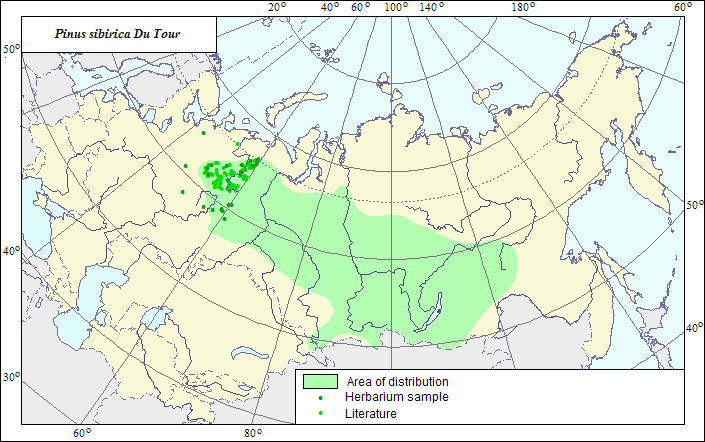
It seems that when professional linguists feel the need to resort often and expressly to the supposed emphasis of their work on “objetive methodology”, it usually turns out to be yet another mere dialectical device born out of a desperate stance. Aikio’s insistence on that end reminds me of Frederik Kortlandt‘s latest papers, German Dziebel’s posts in the Proto-Indo-European group, or Jouna Pyysalo‘s writings, all of which start the defense of their respective far-fetched theories against overwhelming critic views by establishing their personal views of rules governing their reconstructions as The objective ones, a philosophically superior position which down-spirals quickly into a path of self-imposed isolation from the real world of comparative grammar, where – unlike in Science – authority and communis opinio are invaluable to avoid getting lost in absurd dead-end personal crusades.
Despite Aikio’s evident bias, an independent origin of *orja and *ā̆rya- is as reasonable and as possible as chance resemblance always is for any phonetic similarity, but I would say that – given the dozens of proven Pre- and Proto-Indo-Iranian loans in early Uralic dialects – their close relationship seems phonetically and etymologically sufficiently sound to accept that they are, indeed, related. For more on phonetic rules governing the borrowing between Uralic and Indo-Iranian (and how both words fit perfectly well said rules), see Holopainen (2020).
III.2. Uralic *waćara ~ PII **wáȷ́ras
A similar inconsistent direction of borrowing is presented for the (West) Uralic term *waćara ‘hammer’, supposedly from an Indo-Iranian term attested as Av. vazra- ‘mace; weapon of the god Mithra‘ and OInd vájra- ‘thunderbolt; weapon of Indra the god of thunder and war’.
III.2.a) Indo-Iranian origin?
Why Holopainen (2020) believes that “there is no reason to doubt the ultimate Indo-Iranian origin” of the West Uralic word is unclear, since he doesn’t explain this further, despite it representing then an uncommon (late) borrowing from Proto-Indo-Iranian instead of Pre-Proto-Indo-Iranian, hence from the distant Sintashta-Potapovka-Filatovka into the already disintegrated Finno-Saami-Mordvin community of Eastern Europe.
My guess is that this certainty relies on Aikio’s (2015) doubts of the regular equivalence proposed by Häkkinen (2012) of variants PSa/dial. Md. *weśärä ~ PWU *waśara, and the assumption of a borrowing within an already differentiated Balto-Finnic – Saami – Mordvin community; see below for the parallel case of *wäśä. On the other hand, Holopainen (2020) reconstructs it with *ć and doesn’t found therefore a phonetic reason not to (potentially) reconstruct it for Proto-Uralic, contra Parpola’s (2005, 2015) reconstruction involving an origin in depalatalized Skt. vajra-.
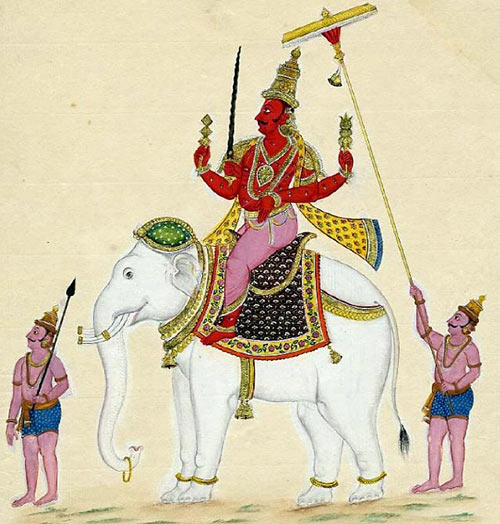
He tries to show a parallel in the potential adoption of the term in Uralic with the common borrowing of other words originally related to mythology, such as PU *Juma. However, it seems equally reasonable to assume the incorporation of a name adopted from Uralic into the expanded mythology of Indo-Iranians, especially because there are no cognates of this word outside Indo-Iranian to reconstruct a parent form.
Tocharian A/B wāśir appears to be a late borrowing coinciding with the Iranian or Indo-Aryan expansions associated with Andronovo-related peoples into Xinjiang, well after the indirect West Uralic – Indo-Iranian contacts, and therefore irrelevant for the original direction of the loan. On the other hand, it could also be hypothetically linked to the strong Pre-Proto-Samoyedic influence on Proto-Tocharian through an unattested Ugro-Samoyedic form.
#EDIT (13 Feb 2020):
III.2.b) The *Juma – *waćara complex
1. The Sámi stormgod Horagalles has a traditional epithet reconstructible as PSa. *ājjē- wećärä (< PFS *äjjä- waćara) ‘(great) grandfather’s hammer’. The epithet ‘old man’ is commonly used in to describe the thunder god (a central sky-god across Finno-Mordvinic dialects), representing a Finno-Samic epithet which may or may not have been originally used to refer to the supposed central Proto-Uralic sky-god *Ilmari (cf. ilman ukko ‘old man of the sky’) before its renewal or replacement by the younger thunder god.
NOTE. This has an interesting parallel in the case of the Indo-European ‘more agricultural’ stormgod NWIE *Perkʷunos and PII *Indra, younger concepts partially renewing or replacing the Indo-Anatolian pair *Dyēus – thunder god (cf. PAn. *tr̥ḫu-ent-) among late dialectal communities.
Akin to the survival of this epithet well after the Christian conversion process among Baltic Finns, it is possible that the god’s magical weapon survived (with its original name) the previous religious creolization event(s) that saw the development of *Juma, due to similar difficulties to those observed when implementing changes in basic vocabulary not especially connected to religious life, as Frog (2017) proposed.
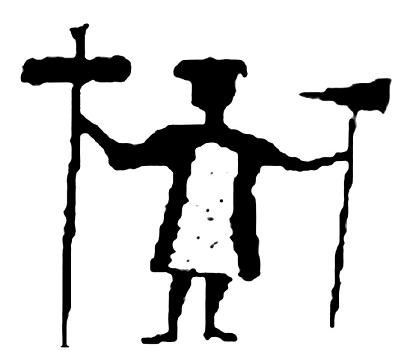
2. In the old epic Kalevalaic poems, one of the smith Ilmarinen’s great feats of skill is that
Ei ole seppeä selvempeä, There is no smith cleverer, Takojoa tarkempoa, no craftsman more precise, Kuin on seppo Ilmorini: than is the smith Ilmorini: Se on taivosen takonun, he has forged heaven, Ilman kannen kalkutellun; hammered the vault of the sky; Ei tunnu vasaran jälki, no trace of a hammer can be felt, Eikä pihtiem pitämät. nor marks of the tongs. (SKVR I1 84, 125–131.)
From Frog (2017):
Several layers of development relevant to the central sky-god can be observed in Finnic. Relevant here are: a) lexical disambiguation of the theonym from the phenomenon “sky, weather, world” in a manner paralleling *juma > *juma-la; b) extending the god’s identity with the role of “smith of heaven”; and c) displacement from the role of central sky-god and contraction of the god’s identity to a mythic smith (of heaven).
3. Regarding the *Juma – *vaśara complex reconstructible for West and Central Uralic, according to Frog (2020):
(…) PF/PV *juma [‘god, sky’], addressed above, found in Finnic (> Sámi and possibly Komi) and Volgic languages. *Juma differs from *Ilma in its ability to function as a common noun for “god”. The loan suggests a reconceptualization of the phenomenon “god” or changes in associated ritual/narrative activity. *Juma appears paralleled by PF/ PV *vaśara [‘hammer’/’axe’] < Indo-Iranian *vaźra (Joki 1973: 339, Rédei 1986–1988: 815), the term for the lightning-weapon of the dragon-slaying god (Watkins 1995: 332, 408–414, West 2007: 251). This mythic object is associated with metal-casting technologies (Watkins 1995: 435–436; cf. Salo 1990: 136–140). The new term may reflect reconceptualizations of lightning (Salo 2006: 75–76) or of the sky-god’s role as a striker of “devils” with lightning in relation to IE models (Valk 1996: 20; cf. Valk, this volume). *Juma appears paralleled by PF/ PV *vaśara [‘hammer’/’axe’]
However, the background of the motif in Indo-Iranian traditions remains obscure rather than clearly being its source. Antti Lahelma (2008: 155–157, 2010: 142–145) has identified a Stone Age petroglyph depiction of this motif on Lake Onega. This attests to an early period of establishment in the north, yet simultaneously complicates matters because the representation may antedate Indo-Iranian contacts and cannot even be unambiguously identified as deriving from an Uralic language group (cf. Carpelan 2001, Aikio 2004). The multicultural isogloss could have extended beyond FU and IE cultures and evidence of additional relevant mythologies are simply lacking.
While arguments based on mythology coupled with archaeology have to be taken with a truckload of salt, it seems relevant to point to potential Stone Age myths in the Forest Zone before the expansion of Indo-Europeans and Uralians to the west and north with their “Steppe ancestry”. Especially because the concept of the stormgod and his magical weapon appears to have undergone relevant changes precisely during the Late PIE and Late Uralic expansions…
4. Disintegrating Uralic *Juma ‘God’ was borrowed from zero-grade PIE *dyu- < *dyeu- ‘sky, sky-god’, and is traditionally explained as from PII **dyu-man ‘radiance’ (also **dyuma(n)t-? in Parpola 2012), in a doubtful reconstruction based on OInd dyumná-, or OAv. diuuamnəm, both meaning ‘divinity, divine glory’. If a common PII reconstruction is accepted, the semantic evolution seems acceptable (it was, after all, an epithet for *Indra), as is the initial consonant change, despite it being the only potential example of PII *dy- → PU *j-.
However, there is no clear parent formation or borrowing scheme for the Uralic suffix, as pointed out by Joki (1973), and Hollopainen’s (2020) ad hoc solution of another similar stem formation (“[w]e do not know what the exact source of the Uralic word was”) means in essence that there is no reason to support a late (PII) borrowing. In fact, based on the many other Late PIE (Pre-PII-like, NWIE-like) loans in Late Uralic in general and shared West–Central Uralic dialects in particular, it is more straightforward to support an older (unnattested) Pre-PII or even (Late?) PIE *dyu-m(e)n- (or *dyu-mna-?) as the ultimate source.
NOTE. As Holopainen (2020) notes, “among the Baltic loanwords of Finnic there are n-stems that are borrowed into Finnic as vocalic stems”, and so can be assumed for the parent language, too.
From Frog (2017):
The loan would most likely have developed to refer to Indo-Iranian supernatural agents as well as vernacular ones. Proto-Indo-Iranian maintained a word *daivas, derivative of Proto-Indo-European *deiwós “god”. If *juma was borrowed as a common noun for “god”, it is reasonable to question why *dyumān-/*dyuma(n)t- was borrowed for this category rather than *daivas.
The Mari, Mordvin and Finnic forms show that the early loan *juma was carried through multiple branches of Proto-Uralic. (…) It belongs to a (potentially very broad) stratum of Indo-Iranian loans. Although it is uncertain, *juma could be linked to the borrowing of *vaźra, probably a term for the celestial god’s lightning-weapon (Watkins 1995: 332, 408–414; West 2007: 251), which yields words for “hammer” (Finnic, Sámi) or “axe” (Mordvin) (Joki 1973: 339; Rédei et al. 1986–1988: 815).
Proto-Finnic *taivas has generally been considered a loan from a derivative of Indo-European *deiwós “god”. Phonologically, neither Proto-Baltic *deivas nor Pre-Germanic *teiwaz would produce /ai/ in Proto-Finnic; *taivas is most probably borrowed from Proto-Indo-Iranian *daivas (e.g. Joki 1973: 323; cf. Kulmar 2005: 23–24). This etymology situates the loan in Early Proto-Finnic and among other lexical evidence of Indo-Iranian impact on celestial mythology, which includes *dyumān-/*dyuma(n)t- > Proto-Finnic, Pre-Mari, Pre-Mordvin *juma, *vaźra > Proto-Finnic, Pre-Mordivin, Proto-Sámi *vaśara, and *stambhas or *skambhas “that which supports, pillar” > Proto-Finnic *sambas “(world) pillar”. The impacts suggested by these loans should not be misconstrued as all necessarily arriving together and in a systematic way. Approaching these loans is more complicated when Finnic, Mordvin, Mari and Sámi language families are recognized as independent branches of Uralic: the spread of Indo-Iranian loans was necessarily through language networks rather than entering a unified proto-language that subsequently diversified. It is unclear which language(s) may have first received a particular loan through direct contact with Proto-Indo-Iranian and which language(s) may have only received it through these networks.
While the Palaeo-Germanic or Proto-Baltic forms can’t be explained as entering Proto-Finnic, the Palaeo-Germanic form can indeed be argued to have entered a previous stage within West Uralic, as could (following the same reasoning for Indo-Iranian, disregarding the initial *t-) any dialectal form of PIE *deiwos, which would not have a different output than PII *daiwas.
III.2.c) The Corded Ware axe-hammer
The common meaning ‘axe’ seems to be also reconstructible for Early Balto-Finnic, which would have lost it through the borrowing of Bal. kirves according to Joki (1988). Parpola (2015) suggests that ‘axe’ is of later Scandinavian influence, but this is more than doubtful due to the absolute lack of Germanic influence in Mordvinic…
There is also a potentially general reasoning about common semantic shifts, which would have a similar parallel e.g. in Türk. balta ‘axe’ ~ Tung. balta ‘big hammer’. On the other hand, this parallel is not found in Indo-Iranian…
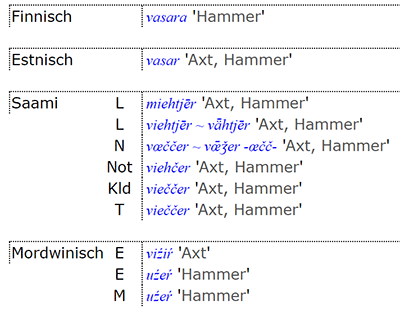
If the reconstructible Proto-Uralic word *waćara had the original meaning of ‘hammer; axe’, and was used for an ancient mythological figure such as the Uralic sky-god and its magical weapon and/or tool, there are little traits more defining of the bearers of the classical Corded Ware culture than votive stone battle axes or axe-hammers deposited in their graves, as well as their preference (even before the emergence of Abashevo) for metal despite their precarious access to it, which might help put all – meaning evolution, borrowings, and mythological relevance – in its true context.
III.3. Uralic *wäśä ~ Indo-Iranian **waćī
This is an even more conflicting case, given the difficulties found when reconstructing a common proto-form behind all Uralic dialects for a term that helps delimit the time and place of the Proto-Uralic community.
The problematic phonetic reconstruction of PU *wäśä ‘(reddish) metal (?); copper’ is properly summarized by Viitso (2012):
- In Saamic, Finnic, and Mordvinic stems the correspondence of stem vowels (i.e. of final vowels of the 2nd syllable) is irregular;
- Words denoting ‘copper’ in Saamic, Finnic, and Mordvinic differ from other Uralic languages because they have a second syllable beginning with a -k- that has no corresponding elements in other languages.
- In Khanty, in the semantically corresponding words the spirant γ or χ occurs instead of a sibilant found in other languages.
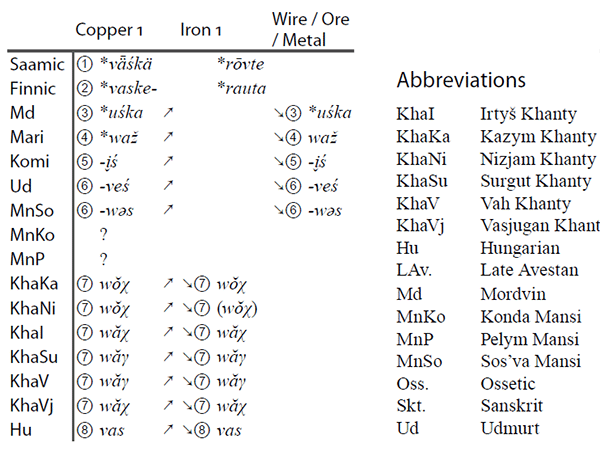
This stem that is not attested as an independent word any longer is identical with the Indo-European stem *vaśa, reconstructed by Asko Parpola (Carpelan & Parpola 2001: 127):
If Proto-Uralic *wäśkä ‘metal’ ends in a Uralic suffix *ka/ kä, Proto-Aryan and Old Indo-Aryan vā́śī ‘bronze axe or adze’ (as a vṛddhi derivative from *vaśa ‘*bronze’) might be related to it.
What remains problematic is the original meaning of the Indo-European stem. The data presented by Alexander Lubotzky (2001: 312) contain no hint to bronze:
*u̯aćī- f. ‘axe, pointed knife’: Skt. vā́śī f. ‘axe, adze, chisel’; LAv. (Yasna 42.4) vāsī ‘pointed knife (?)’, Oss. wæs (better was ?) ‘axe, wood-chopper’.
It must be assumed that axes, adzes, and chisels are older than bronze and have preserved their former names even when made of bronze. Moreover it is improbable that names for ‘thunderbolt’, such as Sanskrit vajraḥ and Finnic *vasama were derived from a metal name.
The borrowed protoform *vaśa in the Uralic languages allows us to explain all later stem variants with front vowels as resulting from the assimilative influence of the palatalized sibilant *ś and all stem variants with the sibilant š or ž as developments of *ś. The occurrence of the spirant χ or γ in Khanty names can be explained by alleging that the metal name was borrowed either from an Iranian dialect where the sibilant had undergone the Iranian local change *ś > *h in 1000–1500 BC or from a Dagestan language, cf. Avar baχ ~ paχ ‘copper’, Chamalal, Hunzib baχ ‘copper’, Bezhta bak ‘copper’.
Despite the difficulties in reconstructing a common stem, there is no reason to assume a common Indo-European form based on the single attestation of the word in Indo-Iranian, whereas *wäśä remains a strong candidate for an original Proto-Uralic stem, basis for the forms attested in all dialects, referring to a tool that would have been easily incorporated into the Indo-Iranian lexicon during the dominance of Abashevo chiefs, or (phonetically and anthropologically) more likely under the areal influence of the Seima-Turbino phenomenon over the disintegrating Indo-Iranian community of Eastern Europe at the end of the 3rd millennium BC.
The borrowing of *wäśä and especially *waćara could have thus coincided chronologically with the intense contacts of Indo-Iranians with the Asian agricultural substratum, which would also fit in the case of *waćara the evolution of the Proto-Indo-European mythology into the Indo-Iranian religion including the borrowed *Indra and its epithet *dyuman.
Regarding hypothetical intermediate steps, Martin Kümmel (2019) considers PII *waćī- as a potential borrowing from an earlier PU *weŋćä ‘knife’, which would have been later back-loaned again into Disintegrating Uralic, attesting to the close interaction of both communities in the mid- to late 3rd millennium BC. While semantically straightforward, the late adoption of an evolved Proto-Indo-Iranian *vaśī doesn’t seem to be a better hypothesis, given the wide distribution of Disintegrating Uralic *wäśä and that West Uralic seems to have been only in indirect contact almost exclusively with Pre-Proto-Indo-Iranian.
This complex setting could nevertheless help explain the (unsurprising) doubts in Aikio (2015) of a reconstructible suffixed PWU *wäskä, despite the common sound substitution attested in PU *ä–ä → PFi *a–e, the regular development *a(–i) → PMd *u, or the parallel change *waś- → *weś- attested also in PSa *weśärä (~ *waśara → Fi. vasara ‘hammer’). His alternative explanation of a Wanderwort across disintegrated West Uralic dialects through areal contact, while possible, seems a much less likely linguistic scenario, especially because these doubts hinge mainly on the vocalism of the PWU suffix… In any case, this theory would paradoxically support:
- The existence of already differentiated Balto-Finnic / Samic / Mordvinic communities in Eastern Europe by the end-3rd millennium BC.
- The ultimate non-Indo-Iranian, likely Proto-Uralic origin of *wäśä, due to the multiple cognates attested in EMBA languages of the Cis- and Trans-Urals regions.
It could then be argued that the relatively late Seima-Turbino phenomenon would have helped spread this remade term up to the Baltic (and indeed to the Trans-Urals), in what could then be described as a true Wanderwort Uralic → Indo-Iranian → Uralic… On the other hand, it seems much simpler in linguistic and archaeological terms to assume that the skilled metallurgists of Abashevo who expanded with Seima-Turbino materials would lend rather than borrow this kind of words to neighbouring Indo-Iranians of the steppe.
A Wanderwort connected to Seima-Turbino and later Abashevo-derived Trans-Uralian groups also explains the existence of Turkic *bakɨr ‘copper’ (PT *b ~ PU *w), associated with Uralic groups eventually in contact with West Siberian peoples, supporting thus the expansion of Uralic-speaking peoples of the Andronovo-like cultural horizon among Palaeo-Siberian groups with less developed metallurgical knowledge.
A similar example is found in Proto-Permic *äz-veś (cf. Ko ezi̮ś ‘silver’, Ud uzveś) potentially explained as a compound of metal terms PU *äsä-wäśä in Csúcs (2005), Häkkinen (2009), and related to the Wanderwort behind Hungarian ezüst ‘silver’ and Ossetic ævzist, ævzæstæ.
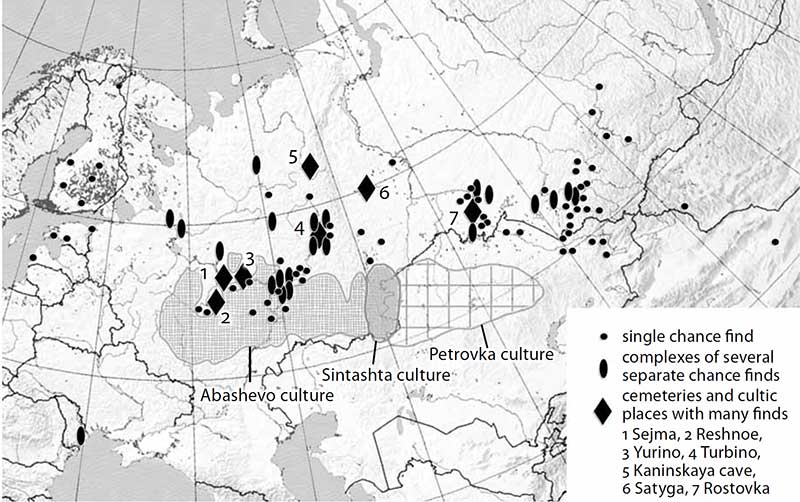
Conclusion
For a myriad reasons that can be summarized as stemming from nativist and traditionalist vindication – which certain national research groups will have to come to terms with in the future – neither Scandinavian (or Germanic in general), Slavic (or Balto-Slavic in general), nor Indo-Iranian studies have dealt with the millennia-long influence of substrate or adstrate Uralic languages in Northern or Eastern Europe, whether in terms of hydrotoponymy, lexical borrowings, morphosyntactic changes, or phonological evolution.
Many researchers seem to be always ready to assume that such extensive contacts were exclusively one-sided, or that they didn’t even exist, at all. In the meantime, apparently the field of Celtic studies is surpassing them regarding the study of Uralic loanwords, which must have been of much less relevance in this Indo-European dialect of Central Europe than in those of Northern and Eastern Europe, given the data offered by archaeology and population genomics; you know, the so-called “third revolution” that still hasn’t shown its impact among many Indo-Europeanists or Uralicists eager to continue supporting their outdated Weltanschauung.
Recent examples of casually dodging this Uralic influence can be seen here for Germanic, here or here for Balto-Slavic, and even in population genomics, all of them on the grounds of the impossibility or unlikeliness of such contacts according to the traditional picture of Corded Ware being a vector of Indo-European languages, and of Uralians as isolated forest hunter-gatherers, hence the implausibility of such a substratum among Germanic or Balto-Slavic peoples.
Sure, but which languages spread with Corded Ware peoples exactly, and how can’t we see their influence in Fennoscandia or the Eastern European forests after supposedly millennia of uninterrupted Indo-European dominance?
These traditional theories of Indo-European Corded Ware peoples and Uralic Volga-Kama hunter-gatherers resemble more and more a big, convoluted vicious circle that seems to be there just to bind their respective fields back to their pre-genomic dark ages…
See also
- Intense but irregular NWIE and Indo-Iranian contacts show Uralic disintegrated in the West
- Samoyedic shows Yeniseic substrate; both influenced Tocharian
- Corded Ware ancestry in North Eurasia and the Uralic expansion
- Haplogroup R1a and CWC ancestry predominate in Fennic, Ugric, and Samoyedic groups
- Uralic speakers formed clines of Corded Ware ancestry with WHG:ANE populations
- Corded Ware—Uralic (III): “Siberian ancestry” and Ugric-Samoyedic expansions
- Genetic continuity among Uralic-speaking cultures in north-eastern Europe
- Volosovo hunter-gatherers started to disappear earlier than previously believed
- European hydrotoponymy (IV): tug of war between Balto-Slavic and West Uralic
- The cradle of Russians, an obvious Finno-Volgaic genetic hotspot
- Aquitanians and Iberians of haplogroup R1b are exactly like Indo-Iranians and Balto-Slavs of haplogroup R1a
- Pre-Germanic and Pre-Balto-Finnic shared vocabulary from Pitted Ware seal hunters
- Pre-Germanic born out of a Proto-Finnic substrate in Scandinavia
- On Proto-Finnic language guesstimates, and its western homeland
- On the origin and spread of haplogroup R1a-Z645 from eastern Europe
